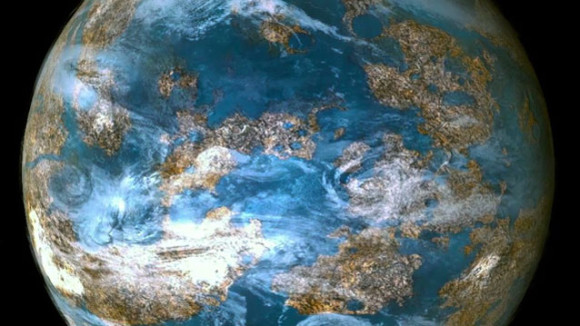
As far as we know, water is life. Earthly life – the only life we know to exist in all the universe – needs water. That’s why – as astronomers contemplate and search for life elsewhere – they want to understand oceans on distant exoplanets, and it’s why astronomers from the Harvard-Smithsonian Center for Astrophysics (CfA) are excited about their new research suggesting that oceans can last for billions of years on super-Earths. The CfA researchers are presenting their results today (January 5, 2015) at the 225th meeting of the American Astronomical Society in Seattle, Washington.
Super-Earths are worlds with more mass than Earth, but less than gas giants like Uranus or Neptune.
Lead author Laura Schaefer of CfA said:
When people consider whether a planet is in the habitable zone, they think about its distance from the star and its temperature. However, they should also think about oceans, and look at super-Earths to find a good sailing or surfing destination.
We call Earth a water planet, but, overall, water makes up only about a tenth of a percent of our planet’s overall mass. study co-author Dimitar Sasselov of CfA said:
Earth’s oceans are a very thin film, like fog on a bathroom mirror.
However, Earth’s water isn’t just on the surface. Studies have shown that Earth’s mantle holds several oceans’ worth of water that was dragged underground by plate tectonics and subduction of the ocean seafloor. Earth’s oceans would disappear due to this process, if it weren’t for water returning to the surface via volcanism (mainly at mid-ocean ridges). Earth maintains its oceans through this planet-wide recycling.
Schaefer used computer simulations to see if this recycling process would take place on super-Earths, which are planets up to five times the mass, or 1.5 times the size, of Earth. She also examined the question of how long it would take oceans to form after the planet cooled enough for its crust to solidify.
She found that planets two to four times the mass of Earth are even better at establishing and maintaining oceans than our Earth. The oceans of super-Earths would persist for at least 10 billion years (unless boiled away by an evolving red giant star).
Interestingly, the largest planet that was studied, five times the mass of Earth, took a while to get going. Its oceans didn’t develop for about a billion years, due to a thicker crust and lithosphere that delayed the start of volcanic outgassing. Schaefer said:
This suggests that if you want to look for life, you should look at older super-Earths.
Bottom line: Astronomers from the Harvard-Smithsonian Center for Astrophysics (CfA) are reporting today (January 5, 2014) at the annual meeting of the American Astronomical Society in Seattle that oceans can last for billions of years on super-Earths.
More results from this week’s AAS meeting:











